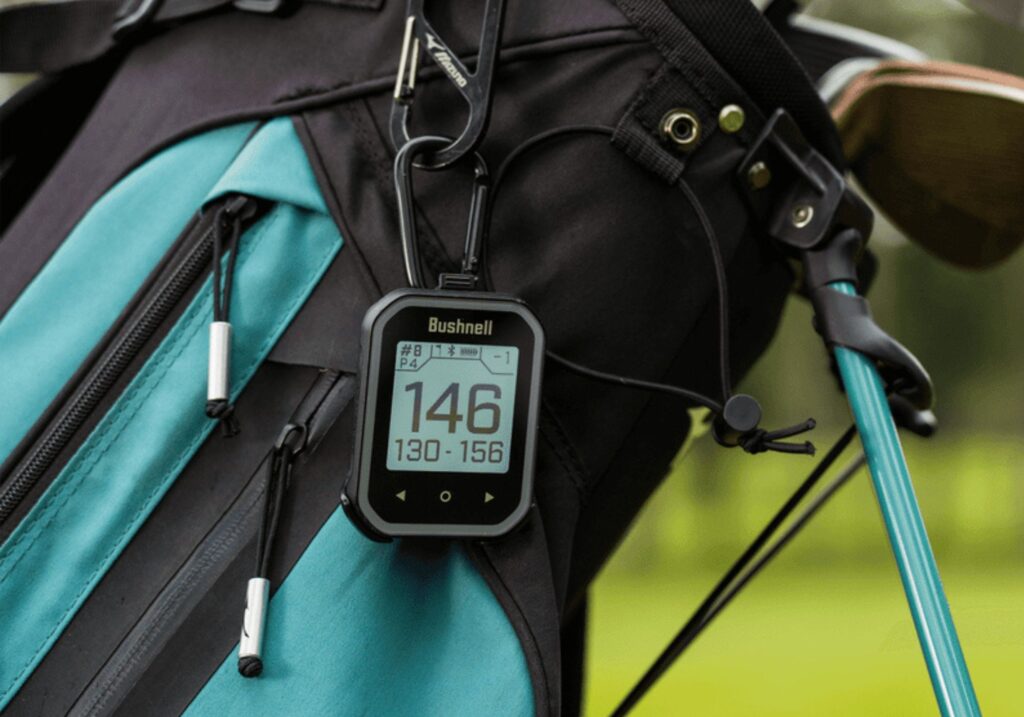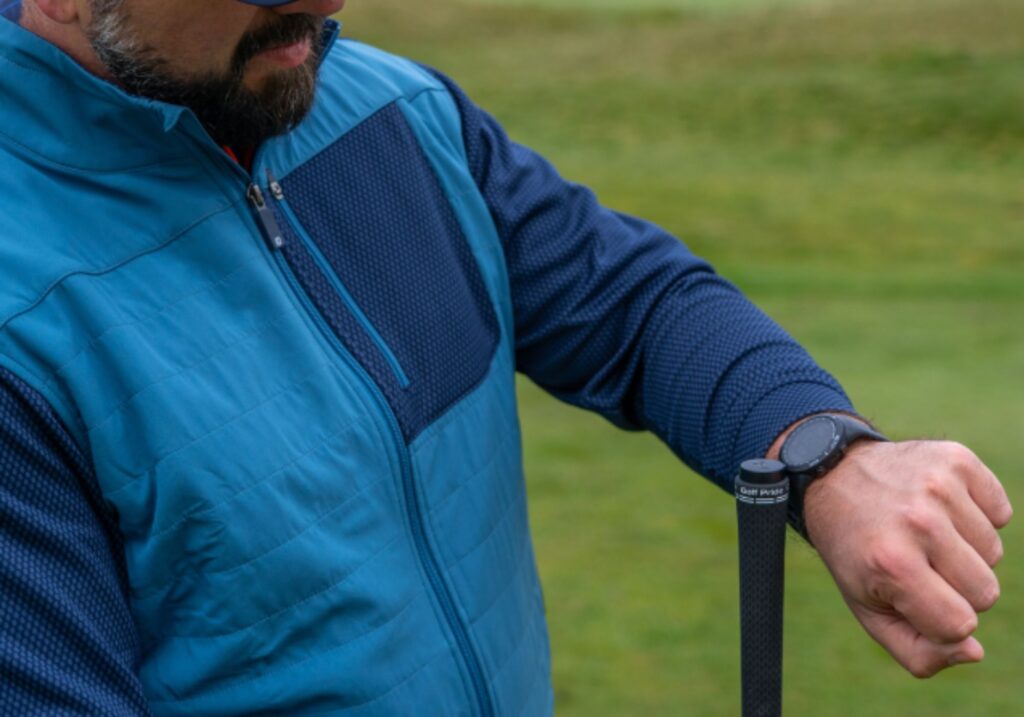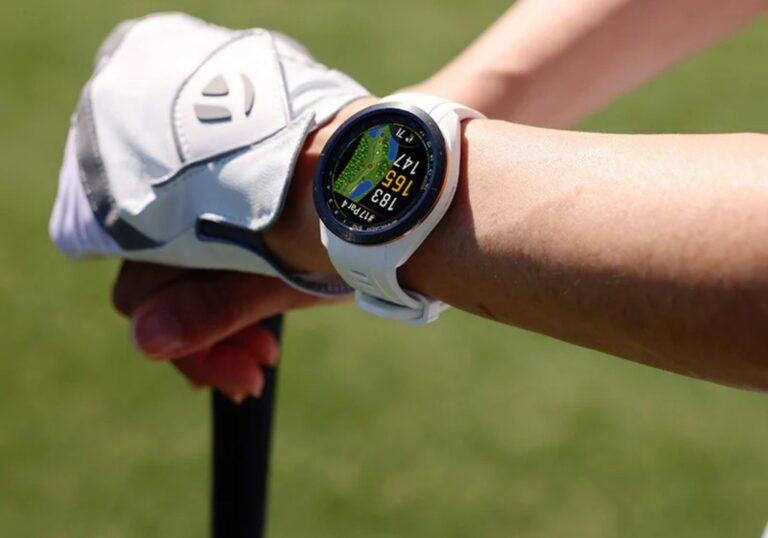Still trying to play off course markers?
If any of these questions sound familiar, it might be time to consider a GPS system:
- What’s the carry over that bunker?
- Where is the back edge of the green?
- How far do I need to lay up?
Whether you’re navigating a tricky hole or just want to make better decisions, GPS systems are one of the easiest ways to get smarter on the course.
Why you should consider a GPS system
Golf GPS tools have come a long way. Watches, handheld devices and phones have apps that can now provide distances to the front, middle, and back of the green. Most systems also show hazard distances, layup spots, dogleg corners and even detailed hole maps.
GPS isn’t about precision to the inch. It’s about awareness. You get a clearer picture of what’s in front of you and how far you really need to hit each shot.
When you know how much room you have to the front or what number leaves you short of the trouble, you start playing more strategically and making fewer mistakes.
It’s also convenient. Most GPS tools are fast, simple and easy to check as you walk up to your ball.

GPS system do’s and don’ts
GPS systems are helpful, but getting the most out of them takes a little know-how.
Do:
- Glance early and plan ahead. Check yardages before it’s your turn so you’re not rushed.
- Use front and back yardages. Knowing the pin is at 142 is helpful, but knowing the green starts at 128 and ends at 156 gives you a full picture.
- Combine it with your strengths. If you hit your 7-iron 150 on a good strike, plan for a safe zone based on your miss tendencies.
- Double-check hazards. Some systems list carry and reach distances separately, so make sure you know which number you’re looking at.
- Use it for layups. On par fives and doglegs, knowing your ideal landing spot is huge for course management.
Don’t:
- Don’t rely only on middle yardages. Greens can be deep or narrow. If you ignore front and back info, you may come up short or go long.
- Don’t stare at it all round. Use it, then put it away and commit to the shot.
- Don’t ignore how far you hit your clubs. GPS gives you the picture, but your club choice still has to match your real carry distance.
- Don’t assume all maps are perfect. Occasionally courses change layout or tees shift. Trust what’s in front of you when something feels off.

Types of GPS systems
There’s more than one way to get GPS data on the course. Each has its own style and strengths. Here’s a look at the most common types.
GPS Watches
Worn on the wrist, GPS watches are fast, convenient and always with you during the round.
- Yardages to front, middle, and back of green
- Some models show hazards and hole layouts
- Great for walkers and minimalists
- Varying levels of battery life
Handheld Devices
Slightly larger than a phone, these provide more screen space and detail.
- Bigger displays with hole overviews
- Easier to use for the eyes or when you want a quick zoom
- Can be mounted on carts or carried in pocket
Phone Apps
Many apps turn your smartphone into a personal GPS tool. Some are free, others offer premium upgrades.
- Intuitive layouts and touch-screen hole views
- Some integrate scorekeeping and shot tracking
- Battery drain can be a concern if used all round
Smart Sensors and Trackers
These systems pair with GPS to track every shot you take, club used and distance.
- Provide post-round stats and insights
- Pair with watches or phones
- Excellent for improving through data over time

Our favorite GPS options (brands and platforms)
You’ve got a lot of great tools to choose from. Here are some of the most well-known and trusted names in the GPS world.
Bushnell
Known for their laser rangefinders, Bushnell also makes GPS watches and handhelds. Their devices are simple to use, reliable, and focus on essential info without extra fluff.
Shot Scope
Offers GPS watches and club tracking systems. Shot Scope’s V5 and X5 watches give clear yardages, hazard views, and automatic stat tracking after each round.
Arccos
One of the most advanced GPS and shot tracking systems. Uses smart sensors in your grips or clubs to track performance, paired with GPS hole views. Great for data-focused golfers who want insights after every round.
Garmin
A leader in GPS across many industries. Garmin makes high-end golf watches and handhelds with vivid displays, customizable stats, and premium course mapping. Their integration of smartwatch features is also a bonus.
The Grint
A popular app for scorekeeping and GPS yardages. Offers a social aspect too, with live scoring and peer tracking. Easy to use and great for casual rounds.
Other Apps
Apps like Golfshot, 18Birdies and GolfLogix offer powerful GPS features, stat tracking, and community features. Many start free, with added features unlocked through premium plans.
Cart-Based GPS Systems
Some courses have GPS built into carts. These are helpful for visuals and quick yardages, but less portable. When you walk or play another course, you’ll want something of your own.
What to consider before choosing
Every golfer is a little different, so ask yourself:
- Do you want something wearable, or do you prefer a handheld screen?
- Do you want simple yardages or in-depth data after every round?
- Do you walk or ride?
- Do you want something that replaces your scorecard and helps with tracking?
GPS tools can be as basic or as advanced as you want. The key is picking one that matches how you like to play.
Final thoughts
A GPS system is one of the easiest upgrades you can make to your game. Whether you’re looking to avoid bunkers, manage your layups, or just stop guessing how far it is to the back of the green, GPS brings clarity and confidence to every hole.
The options are better than ever, and with so many styles to choose from, there’s something that fits every type of golfer.
Your turn
Are you using GPS already? Do you prefer a watch, an app, or something else? Let us know what’s helped your game and what you’d recommend to other golfers looking to improve their course management.
